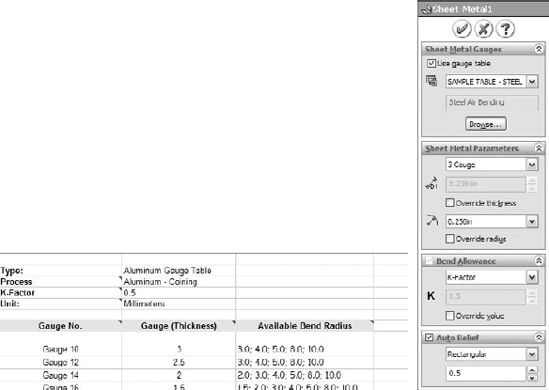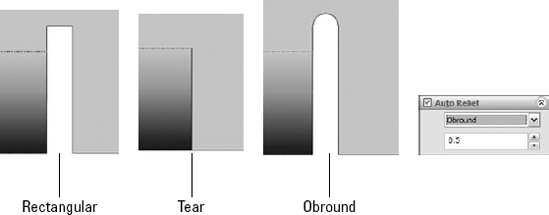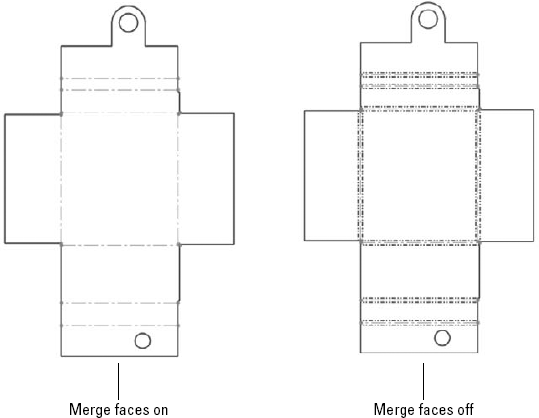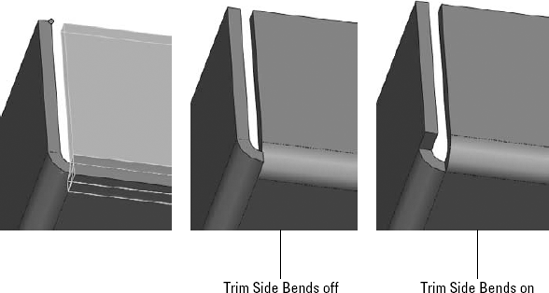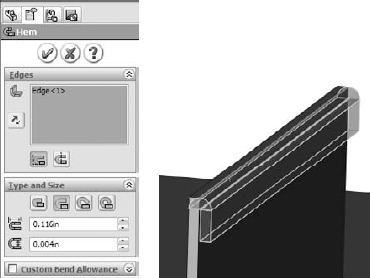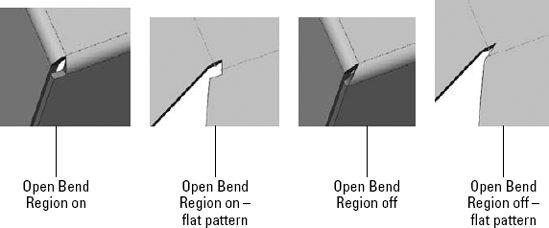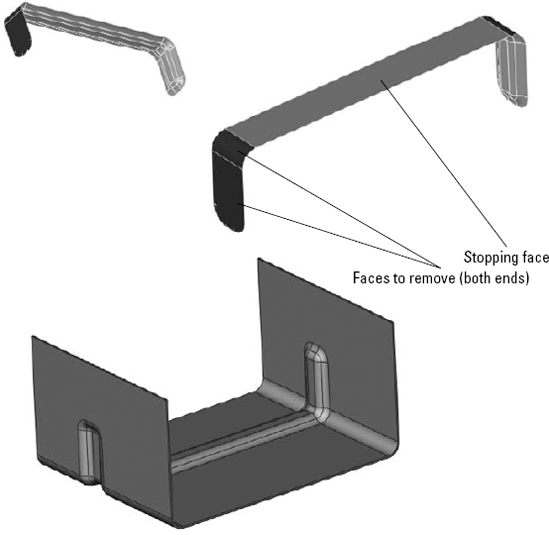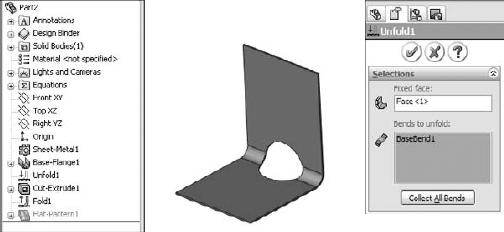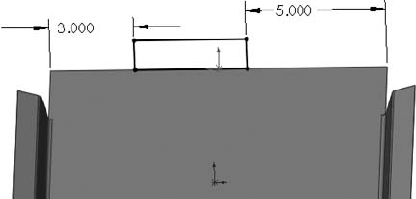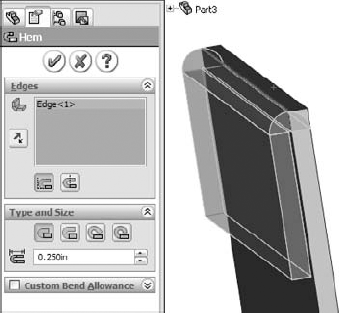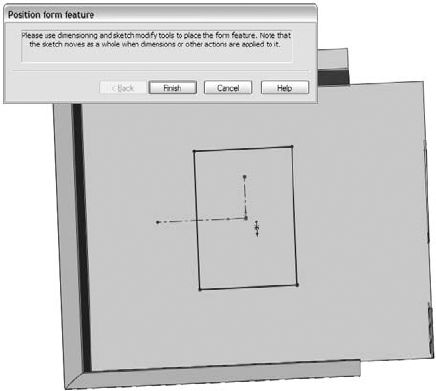IN THIS CHAPTER
Understanding the big picture
Using the Base Flange features
Gauge Tables
Tutorial: Using the Base Flange sheet metal method
Many releases ago, SolidWorks changed the way that the software dealt with sheet metal parts. In the old way, the model was created through normal modeling features, mainly centered around thin feature extrudes, but also including shell features. It did not matter how you got the geometry, as long as it had a consistent thickness and the edge faces were sheared perpendicular to the material. Once the geometry existed, an Insert Bends feature was applied that turned the part into sheet metal and enabled bends to be flattened. In this method, you had to be proficient with working in Rollback states, because most changes to the model had to be done this way. Certain types of features had to go in certain places in the feature tree, corresponding to either a flat or formed state of the model. Although it was possible to do this, SolidWorks was very particular about the details.
The new way uses a functional feature approach, which greatly simplified the feature order requirements, and at the same time added some powerful and easy-to-use feature types. This new way is what we now call the Base Flange method, and is the main tool for sheet metal creation that we use today.
The Insert Bends method is still viable, but it is typically relegated to being used with imported parts and special uses such as creating rolled conical sheet metal parts.
Although I am primarily a plastics designer, the sheet metal tools in SolidWorks work so well and intuitively that I often wish that I did more sheet metal modeling work.
The basic concept with the Base Flange method is that when you insert a Base Flange feature, SolidWorks identifies that part as a sheet metal part. The Base Flange feature is not required to be the first feature in the tree, but it is difficult to imagine why it would not be. You can create multibody sheet metal parts, but you can only insert one Base Flange for each part document, and so only one body can be sheet metal. If you try to create a second Base Flange feature, then SolidWorks interprets it as an attempt to add a tab, which is the alternate function of the Base Flange tool.
When you add the Base Flange feature, a Sheet Metal placeholder feature is also automatically added before the Base Flange feature. The Sheet Metal placeholder is described later in this chapter.
Another feature is added automatically when you add the Base Flange. This one is called the Flat Pattern feature. Sheet Metal is added before the Base Flange and Flat Pattern are added at the bottom of the tree. This feature has a couple of special properties that are not found with other features. The first property is that it remains at the bottom of the tree when you add other sheet metal features, and the second property is that it is added as a suppressed feature. The Flat Pattern feature is discussed in more detail later in this chapter.
Bends may be flattened individually, or the whole part may be flattened at once. Configurations are often created with various bends flattened to show the part in various stages of the manufacturing process.
Bend Allowances can be specified by Bend Table, K-Factor, Bend Allowance, or Bend Deduction. These items are all listed in the Sheet Metal feature that is inserted as the first feature with a Base Flange.
Auto Relief has three options, which you can also set in the Sheet Metal feature. These three options are Rectangular, Tear, and Obround. Auto Relief and Bend Allowance settings are described in detail later in this chapter.
One of the general ideas about SolidWorks sheet metal is that some of the functions must create visual approximations of what the parts are going to look like, especially in the formed part, because the area where two bends run into one another is difficult to model. For this reason, the flat pattern may be easier to depict than the formed geometry. Many users become annoyed when the software simplifies the 3D model, but this is how the software works, and the very fine detail is probably not really needed anyway.
Other limitations that users often encounter when working with sheet metal in SolidWorks occur when they want to depict weld beads, spot welds, or other types of welds on finished parts. There is currently no defined way of doing this, but you can add extruded features to the model that approximate welds. Welds can be created in assembly, and in parts that are designated Weldment parts, much in the same way that parts can be designated Sheet Metal parts. At this time, Sheet Metal and Weldment parts cannot be combined in SolidWorks, although in shop practice that is done frequently. This may be another great enhancement request topic.
I find that when expectations of the software are reasonable, users tend to be more successful and satisfied with the results. I do not mean to make excuses for the software; I am very impressed with the functionality in the sheet metal features in SolidWorks, but it does not do everything, and users still need to use some imagination.
The features used in the Base Flange method are easy to grasp conceptually, although they have many individual controls that may be confusing at first glance. Many of the tools can be changed by pulling handles, by using spin arrows, or by typing in specific numbers or dimensions. Maybe best of all, SolidWorks knows to change the thickness for the entire part at once.
The Sheet Metal features are all available from the Sheet Metal toolbar or through the menus at Insert, Sheet Metal, and by selecting the appropriate tool.
By drawing an open contour in the first feature, the Base Flange creates a feature-like extrusion that includes the rounded corners of the bends.
By drawing a closed contour in the first feature, the Base Flange creates a flat sheet that is shaped like your sketch for you to start from.
When used at any time other than the first feature, it functions as a tab.
Figure 29.1 shows these three functions of the Base Flange/Tab feature.
Notice that the sketch of the part at the left of Figure 29.1 shown in preview has all sharp corners, and that the bend radius is added to each corner. SolidWorks automatically adjusts when bend directions are combined to make sure that the inside radius is always the same regardless of bend direction.
The bends are shown as BaseBend features in the FeatureManager. You can change individual bend radii from the default setting by editing the BaseBend feature, as well as by assigning custom bend allowances on a per-bend basis. You cannot change the bend angle for these particular bends because the angle is controlled through the sketch. However, for other types of bends (such as those created by Edge Flanges), you can adjust the bend angle through the feature PropertyManager.
If you need to, you can reorder all of the bends from a list that you can access from the RMB menu selection, Reorder Bends on the Flat Pattern. This dialog box is shown in Figure 29.2.
The BaseBend features can be suppressed, but the only effect that this has is to prevent the associated bend from flattening when the Flat-Pattern feature is unsuppressed.
The Bend Order setting shown does not appear to have any effect when you are using the Base Flange method. In the Insert Bends method, a warning appears if the part intersects itself during bend operations, as determined by the bend order. This function may have been removed from more recent versions of the software, but the Bend Order options remain.
Gauge Tables enable you to assign a thickness and available inside-bend radii, which limit the choices that the user can make to those in the table. Each K-Factor has a separate table, and the choices listed in the table appear in the drop-down lists in the Sheet Metal PropertyManager. Figure 29.4 shows the top few lines of a sample Gauge Table, and a Sheet Metal PropertyManager when a Gauge Table is used.
If necessary, you can override the values that are used in the Gauge Table by using the override options in the thickness, bend radius, and K-Factor fields.
The Bend Allowance options (Allowance, Deduction, and K-Factor) are explained in more detail later in this chapter.
The Sheet Metal feature is also used in the Insert Bends method, and Fixed Face or Edge selection box is used in that method, but not in the Base Flange method. For information on how to use the setting in the Insert Bends method, see Chapter 30.
This option specifies the default inside bend radius for all bends in the part. You can override values for individual bends or individual features.
The part thickness is grayed out in the Sheet Metal PropertyManager. You can change the value by double-clicking any face of the model. The thickness displays as a blue dimension rather than a black dimension. It is easier to identify if you have dimension names turned on, because it is assigned the name Thickness.
All features in sheet metal parts that use the thickness value use a link value to link all of the feature thicknesses. This makes it easy to globally change the thickness of every feature in the entire sheet metal part.
To save these settings to a template file, you can create a Sheet Metal feature, specify the settings, delete the Sheet Metal features, and then save the file to a template with a special name that represents the settings that you used.
Tip
When a link value is named Thickness, the Extrude dialog box always shows a Link To Thickness option to link the depth of an extrusion to the Thickness link value. If you save a template where Thickness has been created as a link value, then the option is always available to you, regardless of whether or not you are making sheet metal parts.
You can control the Bend Allowance by using one of four options:
Two general types of Bend Tables are available, text-based and Excel-based. The first few rows of each type of table are shown in Figure 29.5. Each table can use K-Factor, Bend Allowance, or Bend Deduction.
Sample Bend Tables can be found in the langenglishSheetmetal Bend Tables subdirectory of the SolidWorks installation directory. While the values may not be what you need, the syntax and organization is correct. You may want to contact your sheet metal fabrication shop to see what they are using for a table or equations.
When sheet metal is formed from a flat sheet, bending the metal causes it to stretch slightly on the outside part of the bend, and to compress slightly on the inside part of the bend. Somewhere across the thickness of the sheet is the Neutral Plane, where there is no stretching or compression. This Neutral Plane can be at various places across the thickness, depending on the material, tooling, and process. The ratio of the distance from the inside bend surface to the Neutral Plane, to the thickness is identified as the K-Factor, where .5 means halfway, 0 means on the inside face, and 1 means on the outside face. Typically, you can expect values between .5 and .3.
Bend Allowance and Bend Deduction are specific length values, not a ratio like the K-Factor. The Bend Allowance is essentially the arclength of the Neutral Plane through the bend region.
The three values are related, as shown in Figure 29.6. The dark rectangle represents the bend area. Material outside of the bend area really does not matter, although it is usually shown and used in the generally accepted formulas about bend calculations for sheet metal.
The ratio t/T (the K-Factor) is usually used from a published table or by asking your sheet metal vendor what values they typically use. The values from the tables have been developed experimentally by bending a piece of metal of known length, and then measuring the arclength of the inside of the bend and the arclength of the outside of the bend. By comparing these numbers to the original linear length of the bent area, you can find the t value and thus the K value. From the K value, the BA (Bend Allowance) value can be calculated and from that, the BD (Bend Deduction) value is easy to find.
The specific formulas for finding these numbers are not as important as an intuitive grasp of what the numbers mean, and how they are used, at least in relation to using SolidWorks to model sheet metal parts. The numbers used to fill out Bend Tables using K, BA, or BD values are typically taken from experimentally developed tables.
Auto reliefs were formerly called Bend reliefs. You can specify three different Auto relief options to be applied automatically to bends that end in the middle of material. These options are illustrated in Figure 29.7.
For the Rectangular and Obround types, you can control the width and the distance past the tangent line of the bend through the Relief Ratio selection box, which is immediately below the type selection box in the Sheet Metal PropertyManager. This ratio is the width of the relief divided by the part thickness. For the Rectangular relief, a ratio of .5 and a thickness of .050 inches means that the relief is .025 inches wide and that it goes .025 inches deeper into the part beyond the tangent line of the bend. The Obround relief goes slightly deeper because it has a full radius after the distance past the tangent line of the bend, and so it essentially goes a total of one full material thickness past the tangent line.
The Tear relief is simply a face-to-face shear of the material with no gap.
The second property of the Flat Pattern feature is that it is added in the suppressed state. When it is unsuppressed, it flattens out the sheet metal bends.
By editing the Flat Pattern feature, you can set a few options. The Flat Pattern PropertyManager is shown in Figure 29.8.
The Fixed Face parameter determines which face remains stationary when the part is flattened out. Generally, the largest face available is selected automatically, but if you want to specify a different face to remain stationary, you can do that here.
When the Merge Faces option is on, it causes the flat pattern to form a single face, rather than being broken up by the tangent lines around the bends. This does a few things. First, selecting the face of the flattened part and clicking Convert Entities (found on the Sketch toolbar) makes an outline of the entire flattened part, which is easier to use for certain programming applications. Second, the edges around the outside are not broken up. Third, the tangent edges around the bends are not shown. The differences between flat patterns with this option on and off are shown in Figure 29.9.
Bend lines are shown in both examples in Figure 29.9.
When you turn on the Simplify Bends option, it simplifies curved edges that are caused by flattening bends to straight lines from arcs or splines. When the option is off, the complex edges remain complex. Simple edges can be cut by standard punches, and do not require CNC-controlled lasers or jets.
The Corner Treatment option controls whether or not a corner treatment is applied to the flat pattern of a part. The corner treatment is illustrated in Figure 29.10. The model used to create this corner used a Miter Flange around the edges of a rectangular sheet.
Edge Flange is intended to turn a 90-degree flange from a selected straight edge in the direction and distance specified using the default thickness for the part. The default process for this feature is that you select the tool, select the edge, and then drag the distance, click a distance reference such as a vertex at the end of another flange of equal length, or type a distance value manually. You can select multiple edges, from a part which do not necessarily need to be consecutive. That is all there is to a simple default flange, although several options give you some additional options for angle, length, and so on. Figure 29.11 shows the Edge Flange PropertyManager, as well as a simple flange.
The Edit Flange Profile button in the Edge Flange PropertyManager enables you to edit a sketch to shape the flange in some way other than rectangular, or to otherwise edit the shape of the flange. Notice in Figure 29.11 that both of the flanges made by a singe flange feature have been edited. You can do this by selecting the flange for which you want to edit the profile before clicking the Edit Flange Profile button.
Note
If you have added dimensions to the sketch, as shown in Figure 29.11, then you will no longer be able to use the arrow to drag the length of the flange. To edit the length, you will need to edit the sketch or double-click the feature, and then double-click the dimensions that you want to change.
You can add holes to the flange profile as nested loops. This allows you to avoid creating additional hole features, but does not allow you to control suppression state independently from the flange feature.
You can make flanges go only part of the way along an edge by pulling one of the end lines back from the edge. This works even though the end lines appear black, and fully defined. A situation where the sketch has been edited this way is shown in the image to the right in Figure 29.11.
This option enables you to override the default inside bend radius that is set for the entire part for this feature. The bend radii for individual bends within an edge flange that has multiple flanges cannot be set; the only override is at the feature level. If you need individual bends to have different bend radii, then you need to do this using multiple Edge Flange features.
The gap distance is illustrated in Figure 29.12. The Gap Distance selection box is only active when you have selected multiple edges in the main selection box for this feature. The gap refers to the space between the inside corners of the perpendicular flanges.
Because the Edge Flange is not dependent on a sketch for its angle like the Base Flange is, you can set the angle in the Angle panel of the PropertyManager. The values that this selection box can accept range from any value larger than zero to any value smaller than 180. Of course, each flange has practical limits. In the flange shown in Figure 29.13, the limitation is reached when the bend radius runs into the rectangular notch in the middle of the flange to the right, at about 158 degrees. The angle affects all of the flanges that are made with the feature. To create a situation where different flanges have different angles, you need to create separate flange features.
As mentioned earlier, if you have edited the Flange Profile sketch and a flange length dimension is applied in the sketch, then the flange length is taken from that sketch dimension. If this dimension has not been added to the profile sketch, then the options for this setting in the PropertyManager Flange Length panel are Blind and Up To Vertex. Using Up To Vertex is a nice way to link the lengths of several flanges.
The small icons for Flange Position should be fairly self-explanatory, with the dotted lines indicating the existing end of the material. The names for these options, in order from left to right, are:
Material Inside
Material Outside
Bend Outside
Bend From Virtual Sharp (for use when an angle is involved)
In situations where a new flange is created next to an existing flange, and a relief must be made in the existing flange to accommodate the new flange, you can turn this option on to trim back the existing flange. Leaving this option off simply creates a relief cut, as shown in Figure 29.14.
Edge Flanges can be created on curved edges, but the curved edge must be on a planar face. For example, if the part were the top of a mailbox, then an Edge Flange could not be put on the curve on the top of the mailbox. The flange would have to be made as a part of the flat end of the mailbox, instead.
Figure 29.15 shows Edge Flanges used on a part. Notice that reliefs are added to the ends of the bends, although they are not really needed.
All of the edges that you select to be used with a curved Edge Flange must be tangent. This means that in Figure 29.15, neither of the Edge Flanges could have been extended around the ends of the part. You would need to create separate Edge Flange features for those edges.
Because these Edge Flanges are made in such a way that they are developable surfaces, they can be (and are) flattened in such a way that they do not stretch the material of the flange when the flat is compared to the formed shape. Doubtless there is some deformation in between the two states in the actual forming of this flange, and so its manufacturing accuracy may not be completely reliable.
A Miter Flange feature starts off with a sketch that is perpendicular to the starting edge of the Miter Flange feature.
Tip
A quick way to start a sketch for a Miter Flange that is on a plane perpendicular to a selected edge is to select the edge, and then click a sketch tool. This automatically creates a plane perpendicular to the edge at the nearest endpoint.
Miter Flange sketches may have single lines or multiple lines. They may even have arcs. Still, remember that just because you can make it in SolidWorks does not mean that the manufacturer can make it. It is often a good idea to check with the manufacturer to ensure that the part can be made. Also, you usually learn something from the experience.
Tip
When selecting edges for the Miter Flange to go on, be sure to remain consistent in your selection. If you start by selecting an edge on the top of the part, then you should continue selecting edges on the top of the part. If you do not, then SolidWorks prompts you with a warning message in a tooltip that says that the edge is on the wrong face.
Some of the controls in the Miter Flange PropertyManager should be familiar by now, such as Use Default Radius, Flange Position, Trim Side Bends, and Gap Distance. You have seen these controls before in the Edge Flange PropertyManager.
The Start/End Offset panel enables you to pull a Miter Flange back from an edge without using a cut. If you need an intermittent flange, then you may need to use cuts or multiple Miter Flange features, as shown in Figure 29.17.
One of the limitations to keep in mind with regard to hems is that SolidWorks cannot fold over a part so that the faces touch perfectly line-on-line. Doing this would cause the two sections of the part to merge into a larger piece, thus removing the coincident faces. SolidWorks, computers, and mathematics in general do not always handle the number zero very well. In reality, you can often see light through these hems, and so a perfectly flush hem may not be as accurate as it seems.
The Jog feature is created from a single sketch line on the face of a sheet metal part. The geometry to be jogged should not have any side bends; it should be a simple tab-like flange, as shown in Figure 29.19. The line to create the jog can be drawn at an angle, causing the jog to also be angled.
The three icons on the Jog Offset panel illustrate what dimension is being controlled by that setting.
Like most sheet metal features, the Jog feature bends faces on the part, and when it does so, although it may be obvious to you as the user, it is not obvious to the software which face should remain stationary and which faces should be moved by the bend. The Fixed Face selection box enables you to select a face, or in this case, a part of a face, that you want to remain stationary as the rest of the faces move. The black dot on the face identifies it as stationary.
Tip
Problems can sometimes arise when using configurations that change sizes, because these markers for fixed faces can be pushed onto other faces. This can cause problems with assemblies and drawings, and in general makes visualization difficult. In cases like this, it may be advisable to select a larger face or one that has fewer changes, if possible, to be used as the fixed face.
You can control the direction of the jog by using the arrow button to the left of the end condition selection box.
You can control the jog distance by selecting the end conditions, Up To Surface, Up To Vertex, or Offset From Surface. The default setting is Blind, in which you simply enter a distance for the offset, in exactly the same way that end conditions are controlled for features such as extrudes.
One setting that may not be obvious is the Fix Projected Length. This refers to the length of the flange that the jog is altering. In Figure 29.19, you can see that the height of the jogged feature is the same as the height of the original feature. The jog obviously requires more material than the original, but the Fix Projected Length option is turned on, and so the height is maintained. If you turned this option off, then the finished height of the flange after the jog is added would be shorter, because the material is used by the jog, and additional material would not be added. For comparison, the image to the right in Figure 29.19 shows this situation.
Tip
You can use the Sketched Bend feature to "dog ear" corners. You do this by drawing a line across the corner at an angle and setting the angle to 180 degrees and then overriding the default radius with a much smaller one, such as .001 inches.
Unlike Jog, the Sketched Bend feature does not show you a preview. The Sketched Bend PropertyManager is shown in Figure 29.20.
You must select the thickness face of one of the flanges in order to extend it. Selecting one face automatically selects the matching face from the other flange that you also want to extend. The Corner Type selection icons depict the selected face as red, and the three icons display tooltips: Butt, Overlap, and Underlap.
The Gap setting enables you to specify how close you want the closed corner to be. Keep in mind that you cannot use the number zero in this field. If you do, then SolidWorks reminds you to "Please enter a number greater than or equal to 0.00003937 and less than or equal to 0.86388126." It is good to know your limits.
The Overlap/Underlap ratio setting controls how far across the overlapped face the overlapping flange reaches. Full overlap is a ratio of 1, and a Butt condition is (roughly) a ratio of zero. This ratio is only available when you have specified Overlap or Underlap for the corner type.
The Open Bend Region option affects how the finished corner looks in the bend area. If Open Bend Region is turned on, then a small gap is created at the end of the bend. If the option is turned off, then SolidWorks fills this area with geometry. Figure 29.22 shows the finished model with this option on and off, as well as the resulting flat patterns for each setting.
When finished, the Corner Trim feature places itself after the Flat Pattern feature in the FeatureManager. It similarly follows the suppress/unsuppress state of the Flat Pattern feature. When the Break Corner feature is used on its own, it is placed before the Flat Pattern feature. With this in mind, it seems best to use Break Corner as a separate feature unless it is being used specifically to alter the flat pattern in a way that cannot be done from the folded state.
Break Corner on its own is primarily used to remove sharp corners using either a chamfer or a rounded corner. This tool is set up to filter edges on the thickness of sheet metal parts, which is useful, because these edges are otherwise difficult to select without a lot of zooming. Break Corner can also break interior corners.
One of the main functions of the Corner Trim feature is to apply bend relief geometry to the flat pattern. The three available options are Circular, Square, and Bend Waist. These options are shown in Figure 29.24.
One of the important things to understand about forming tools is that they do not stretch the material in the SolidWorks part in the same way that happens in a real-life forming operation. In real life, material is thinned when it is punched, stamped, or drawn. In SolidWorks, the thickness of a sheet metal part remains the same, regardless of what happens to it. For this reason, you need to be careful when using mass properties of sheet metal parts or doing stress analysis of parts that have formed features.
SolidWorks installs with a library of fairly simple forming tools that you can use as a starting point for your own personal customized library. You can also examine some of these tools to see how they create particular effects. The library is found in your Design Library in the Task pane. Some of the more interesting forming tools are the lances and louvers.
Forming tools are essentially a part that is used to form another part. One flat face of the forming tool part is designated as a Stopping Face, which is placed flush with the top face of the sheet metal part. You can move and rotate the tool with the Modify Sketch tool, and you can use dimensions or sketch relations to locate it.
Creating forming tools is far easier than it used to be, and with a little creativity, it can give good results. This section of the chapter gives you the information that you need to effectively create useful forming tools, and a couple of hints for more complex forming tool creation.
To create a forming tool, you can use the Forming Tool button on the Sheet Metal toolbar. Figure 29.25 shows the PropertyManager interface for this tool.
The Stopping Face turns a special color, and so do any faces that are selected in the Faces To Remove selection box. Faces To Remove means that those faces will be cutouts in the sheet metal part.
Another aspect of the forming tool is the orientation sketch. The orientation sketch is created automatically by using Convert Entities on the Stopping Face. If you have used this function in any of its previous versions, then you know that this latest iteration is far easier to create than before. However, to me, it looks like the orientation sketch has taken a step backwards. The orientation sketch cannot be manually edited, and so for forming tools where footprints are symmetrical, but other features in the tool are not, you cannot tell from the sketch which direction the forming tool should face. Orientation could be managed more easily in earlier versions of forming tools because the placement sketch was just a manually created sketch.
When creating a forming tool, you must remember to build in generous draft and fillets, and not to build undercuts into the tool. Also keep in mind that when you have a concave fillet face on the tool, the radius becomes smaller by the thickness of the sheet metal; as a result, you must be careful about minimum radius values on forming tools. If there is a concave face on the tool that has a .060-inch radius and the tool is applied to a part with a .060-inch thickness, then the tool will cause an error. Errors in applied forming tools cannot be edited or repaired, except by changing dimensions.
Once the forming tool is created, special colors are used for every face on the part. For example, the Stopping Face is a light blue color, Faces To Remove are red, and all of the other faces are yellow. Figure 29.26 shows the small addition that is made to the FeatureManager when you make a part into a forming tool. This feature did not exist in older versions of the tool.
The folder that the forming tools are placed into in the Design Library must be designated as a Forming Tool folder. To do this, right-click the folder that contains the forming tools and select Forming Tool Folder (a check mark appears next to this option).
To place a forming tool on a sheet metal part (forming tools are only allowed on sheet metal parts), you can drag the tool from the library and drop it on the face of the sheet metal part. Forming tools are limited to flat faces.
From there, you can use the Modify Sketch tool to move and rotate the forming tool. It may be difficult to orient it properly without first placing it, seeing what orientation it ends up in, and then reorienting it if necessary.
Configurations cannot be used with forming tools like they can with library features, although you can change dimensions by double-clicking the Forming Tool icon in the sheet metal part FeatureManager.
Forming tools are suppressed when the part is flattened.
One application of forming tools that is asked for frequently is the cross break to stiffen a large, flat sheet metal face. SolidWorks does not have a tool to deal with this directly, and it is clearly not something that SolidWorks can do using straight bends, but a forming tool can do it.
You can create the forming tool by lofting a rectangle to a sketch point on a plane slightly offset from the plane of the rectangle. This creates a shallow pyramid shape. Open the part from the material on the CD-ROM for Chapter 29, called Chapter 29 – Cross Break.SLDPRT, to examine how this part was made. Figure 29.27 shows the Cross Break tool applied to a sheet metal part.
A second special technique is a gusset or a form that goes across bends. This can be adapted in many ways, but here it is shown going across two bends. I cannot confirm the practicality of actually manufacturing something like this, but I have seen it done.
The technique used here is to call the single long flat face of the forming tool the Stopping Face. The vertical faces on the ends and the fillet faces must be selected in the Faces To Remove selection box. The fillets of the outside of the forming tool also have to match the bends of the sheet metal part exactly. You may need to edit this part each time you use it, unless it is applied to parts with bends of the same size and separated by the same amount.
When you place the tool on the sheet metal part, you must place it accurately from side to side to get everything to work out properly.
This part is in the same location as the Cross Break file, and is called Chapter 29 – Form Across Bends.SLDPRT. Figure 29.28 shows the tool and a part to which it has been applied.
Lofted Bends is not part of the Base Flange method, but it is part of the newer set of sheet metal tools that are available in SolidWorks.
Figure 29.29 shows what is probably the most common application of this feature. The bend lines shown must be established in the PropertyManager when you create or edit the feature. Bend Lines are only an option if both profiles have the same number of straight lines. For example, if one of the profiles is a circle instead of a rectangle with very large fillets, then the Bend Lines options are not available in the PropertyManager.
Like the forming tools, you can also use Lofted Bends in situations for which they were probably not intended. Figure 29.29 shows how lofting between 3D curves can also create shapes that can be flattened in SolidWorks. In this case, a couple of intermediate steps were required to get to the 3D curves, which involve surface features.
Figure 29.30 shows the FeatureManager of a part where this combination has been applied, as well as the part itself, showing the bend across a hole, and the PropertyManager, which is the same for both features.
Both the Unfold and Fold features make it easy to select the bends without zooming in, even for small bends. A filter is placed on the cursor when the command is active, which allows only bends to be selected. The Collect All Bends option also becomes available. This feature also requires that you select a stationary face to hold still while the rest of the model moves during the unfolding and folding process.
SolidWorks Base Flange method sheet metal is fun and easy to use as you will see in this tutorial:
Open a new part using a special sheet metal template if one is available.
On the Top plane, draw a rectangle centered on the Origin, 14 inches in X by 12 inches in Y (or Z).
Initiate the Base Flange tool, accept the default thickness of .029 inches, and change the K-Factor to .43. Notice that the default inside bend radius is not shown. This setting is made in the Sheet Metal feature that is placed before the Base Flange feature in the FeatureManager.
After the Base Flange has been created, edit the Sheet Metal feature, and change the default bend radius to .050 inches.
Click one of the 12-inch edges and then select the Line tool from the Sketch toolbar. This is a shortcut to creating a plane perpendicular to the end of the edge and opening a new sketch on the plane. This is useful in other situations in addition to working with sheet metal. Draw a sketch similar to that shown in Figure 29.31. The arc overrides the default inside bend radius setting, and directly controls that particular bend.
With the sketch still active, press the Miter Flange button on the Sheet Metal toolbar. Use the settings shown in the image to the right in Figure 29.32. Select three edges as shown. Remember to select the edges on the same side of the Base Flange. In particular, notice the Start/End offset settings. Click OK when you are satisfied with the settings.
Select the remaining edge that is not touched by the Miter Flange, and click the Edge Flange tool on the Sheet Metal toolbar. Double-click the top point of one end of the Miter Flange to establish the flange length, using the Up To Vertex end condition.
Press the Edit Flange Profile button in the PropertyManager, and manually pull the sketch back from the ends of the flange. Add dimensions to make the flange 3 inches from the corner on the left side, and 5 inches from the corner on the right side, as shown in Figure 29.33; otherwise, use the default settings for the flange. Click OK to accept the feature when you are satisfied with the settings.
Select the inside edge of the top of the Edge Flange that you have just created, and initiate a Hem feature. Use the settings Material Inside, Closed Hem, with a length of .25 inches, and make the material go toward the inside of the box. The settings and preview of the feature are shown in Figure 29.34.
Create a second Edge Flange the same height as the first, just to the right of the first flange, as seen from the point of view used in Figure 29.33. Edit the flange profile and pull the new flange away from the existing flange. Add a dimension to make the new flange 2 inches wide. Click OK when you are satisfied with the settings.
Open a sketch on the inside face of the new Edge Flange and draw a line across the flange .75 inches from the end.
Create a Jog feature with the settings shown in Figure 29.35. Make sure to set a custom bend radius by deselecting the Use Default Radius option and entering .025 inches. If you do not set the custom radius, then you may get a warning that the jog distance is less than a minimum jog value.
From the CD-ROM, in the folder for Chapter 29, find the part named Chapter 29 – Cross Break.SLDPRT. Copy this file to a folder in the library that you have established outside of your SolidWorks installation folder, called Forming Tools.
Make sure that this folder appears in the Design Library. You may have to press F5 or the Refresh button at the top of the Task pane. When the folder appears, RMB click the folder and activate the check mark next to Forming Tools Folder.
When the file has been copied and the folder has been assigned as a Forming Tool folder, drag the Chapter 29 – Cross Break part from the folder and onto the big flat face of the sheet metal part. You will be put into a sketch that looks like Figure 29.36.
Once you have dropped the feature into the sketch, drag the Origin of the sketch onto the Origin of the part, and then click Finish. Notice that the cross break is in the middle of the part, but is too small.
Double-click the new feature in the FeatureManager; a set of dimensions appear on the screen. Change the 4-inch dimension to 13.9 inches, and the 6-inch dimension to 11.9 inches. The cross break should now look like Figure 29.37.
Create a new configuration named Flat. In this configuration, suppress the forming tool that you just placed, and unsuppress the Flat Pattern feature at the bottom of the tree.
The newer set of sheet metal tools that are available in SolidWorks is known as the Base Flange method. These tools are extremely powerful, and in most cases are very easy to use and understand. The setup of defaults is kept in the initial Sheet Metal feature, and all of the bends and bend lines are contained in the final Flat Pattern feature.




